Tisbury Audio Mini Passive Preamplifier II
Sometimes, it’s the little things that drive you crazy… take, for example, gain. It seems there’s always too much or too little, never the perfect Goldilocks amount. At the very high end, you can purchase a preamp and power amp from the same vendor and they will work, in concert, to dial up only the gain needed to drive the load. To my dismay, I didn’t win the recent Powerball jackpot, and thus cannot afford such exquisite engineering.
As you may know, I have a modest power amp as my reference, the lovely 40 W into 8 Ω Lindell AMPX. At the moment, it’s driving a pair of equally satisfying Fritz Morel 6 vented, stand mounted two ways, nominally rated at 8 Ω. For a while, I also had a set of sealed, stand mounted two way ARCONA 40s, the subject of last quarter’s review. The AMPX is usually driven directly by an exaSound e22 DAC, via a set of Soundstring GEN II Beta 2-22S XLR to XLR cables…
Here’s the rub; depending on the content I’m playing, I can sometimes leave the source gain at or near full volume. This is the case mostly with classical recordings that have a fair amount of headroom built in. At the other extreme, “popular” music, such as rock or dance, usually requires up to 24 dB of padding or loss somewhere ahead of the power amp so either it (or I) doesn’t clip. To better address a gain staging mismatch, some more enlightened power amplifier manufacturers have input sensitivity controls since, due to specsmanship wars, not as many hi–fi sources actually send 1 Volt nominal peak–to–peak signals anymore. These days, you often find output voltages to be closer to 2 Volts than 1. My power amp lacks any input sensitivity adjustment so, I’ve had to look elsewhere…
I can add the needed loss in one of three ways; in Sonic Studio’s Amarra, my player software; in the e22; or as a resistive pad between the DAC and the AMPX. I have a 20 dB H–pad that I can insert at the amps inputs, but it’s fixed and is seldom the right amount of loss for the program at hand…What to do? Although I prefer the sound of Amarra’s volume control over the e22’s (sorry George), neither strikes me as neutral as the plain ol’ passive H pad. When Wes Young at Tisbury Audio offered an eval of their Mini Passive Preamplifier II, I thought, “This might be just the thing!”
In due time, the Mini Passive arrived from the UK, where it is assembled in its entirely. The Mini moniker is apropos; this critter is small, while also being light but well made.
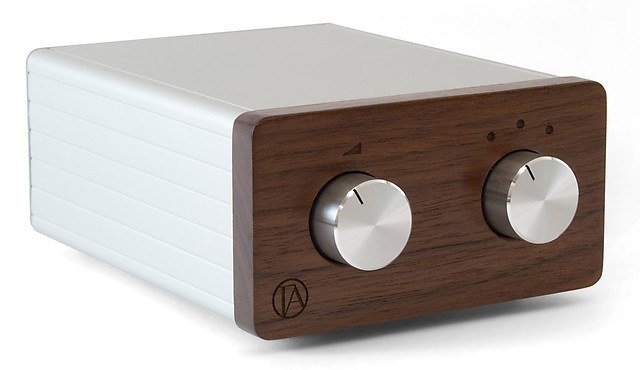
The Tisbury Audio Mini Passive Preamplifier II
An extruded aluminum case houses a stepped attenuator with gold wiping contacts in a series configuration. Wes Young likens the internal variable attenuator, sourced from a 3rd party, as “…essentially a potentiometer that uses a track of resistors instead of carbon film.” The resistors are 1% tolerance thin metal film, providing low noise and close, ±0.25 dB balance between channels at all settings. The three position rotary input selector is from Lorlin Electronics LTD in the UK.
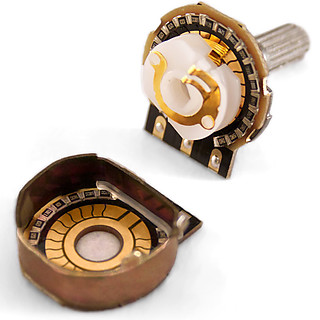
The Mini Passive’s stepped attenuator
As with any other passive “preamps,” including its transformer–based “magnetic” cousins, this isn’t. A preamp, that is. In my mind, a preamplifier is just that; an active device that provides some form of current and/or voltage buffering, gain or loss. So, why use a passive device? In theory, less noise – noise not incurred in one or more active stages. With any device, whether it be purely resistive, inductive or active there is a noise penalty, specifically Johnson-Nyquist noise or thermal noise, resulting from charge carriers banging around inside a conductor. Resistors, being resistive, carry more of a thermal noise penalty than a conductor. A cheap resistor, like a carbon composite type, is noisier than a fancy metal film. Inductive “preamps” contribute lower noise but carry their own issues; mostly low frequency distortion, group delay and non-linear frequency response. A well behaved transformer is relatively costly, so better quality “magnetic preamps” are easily an order of magnitude more expensive than the US$149 Mini Passive.
An optimal match for power transfer is equal source and input impedance but, when that isn’t possible, which is mostly the case these days, a lower output impedance should “see” a higher impedance for whatever it’s plugged into…low output into high input. As an example, my solid state Lindell amp has a 47 kΩ input impedance. When asked about the input and output impedance of the Mini Passive II, Young clarified that, though the 10 kΩ input impedance remains constant, “…output impedance varies from 0 to 2.5 kΩ depending on volume position” or knob setting. He pointed out that there could be some misconception about the meaning of those numbers, which is why it’s not listed on the website. “Because the output impedance drops to 0 Ohms at full volume, no maximum volume is lost as can happen with…high output impedance devices.” By “high output impedance devices,” he means resistive “shunt”–type attenuators, which have high output impedance across their whole operating range. This topology causes a more pronounced impedance mismatch which, in turn, can cause parasitic cable capacitance to act as a low pass filter. Using the 10 KΩ series attenuator configuration negates, for the most part, these effects.
Notice the roman numeral designation in the product name…As the web site notes, “Our second generation preamp now has 3 inputs, 2 configurable outputs and a laser engraved walnut + aluminum enclosure. The chassis is longer, more substantial and remains stable with heavy cables.” I have to take exception to the stability claim but, more on that later. As this is an unbalanced device, there are three RCA inputs on the back, switch–selectable from the front panel. Also on the back are two outputs, labeled numerically as are the inputs.
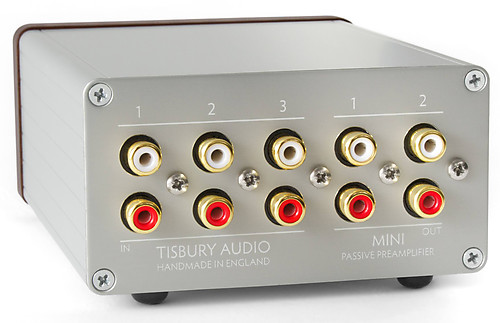
The business end
A rather spiffy feature of the Mini Passive is the second output. It is user configurable, via DIP switches accessible from cutouts on the bottom, to replicate output 1, or to pass through the input. This pass through, or “Loop” through as it’s labeled, bypasses all attenuation. You can also disable Output 2 entirely.
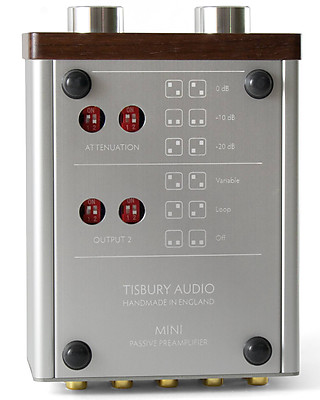
User selectable DIP switches
Notice the other set of stereo switches: ATTENUATION. If you find that the range of operation for the front panel variable attenuator is too narrow, say 12 o’clock still blasts you out of your chair, you can add 10 or 20 dB of fixed loss in front of the variable attenuator. That 10 or 20 dB of pre–attenuation is also achieved with 1% tolerance axial lead metal film resistors. With today’s hyper–power amps, this is quite a useful feature.
Inside the unit is a single, double sided PCB or printed circuit board with through–hole devices soldered on. A generous ground plane on both sides keeps things as quiet as possible. The input selector switch is on a right angle, soldered–in header.
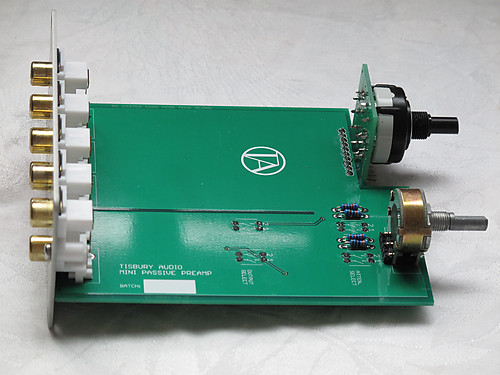
The top of the PCB
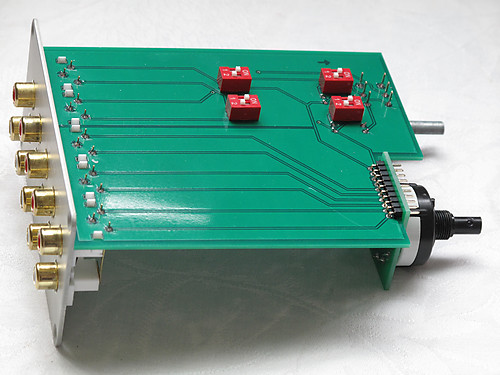
PCB bottom with the fixed attenuation and Output 2 function switches
On to listening…because this is a unbalanced, passive device, cabling along with source and power amp input impedances are very much part of the overall sound. For this review, I needed the best quality I could obtain in cables that I didn’t already have in my collection. Once again I ask, “What to do?” Call on your friends for help, of course! Occasional client and colleague Paul Speltz at AntiCable Audio was kind enough to supply me with some short jumpers, as minimalist and transparent as I could hope for. He built me a set of 12″ AntiCable Level 6.2 RCA/RCA, his top of the line analog interconnect, to feed the output of my e22 into the Mini Passive. Since my rig usually is balanced from DAC to power amp, I also needed another set of cables; RCA to XLR. For those, I contacted Len Miller at Soundstring Cable Technologies. Len had supplied me with my extremely resolving 10′ XLR-XLR, so I asked him for an unbalanced reference. He also went with top tier, creating up a set of 10′ GEN II Beta 2-22S RCA/XLR for me and dispatching them post haste. With reference–grade cabling in place, I was now able to hear the differences in the three methods of signal reduction I mentioned earlier…

Making the connections…
After level matching with pink noise before each run, I started with the unbalanced outputs of the e22 set to unity gain. Regarding the Tisbury versus my custom, Nelson Pass–designed Rocness BA-3 preamp, the Tisbury provided a very subtle veil, a softening with loss of the highest frequencies. Imaging also suffered a bit, with a narrower, more amorphous soundstage. All of this was only noticeable on really well recorded, truly HRA material.
I then took my active preamp out of the chain to tease out any differences between my DAC’s gain control, my software player’s gain control, and the Mini Passive. Comparing loss via the Tisbury against the e22 set at -6.5 and the Tisbury set at 3 o’clock, the Tisbury won by a hair! The e22 had a subtle brassiness, with a faint shroud cast over the music. The Tisbury had more space around each instrument, with reverb distinct from the direct send. The music was simply more engaging. Bringing the e22 up to unity gain, and instead setting Amarra Symphony to -16 with shaped redithering to 24 bits and the Mini Passive at 2 o’clock, I preferred Amarra’s more open presentation by a touch. The Tisbury incurred a tiny loss of apparent resolution. For all of the comparisons, I matched levels with pink noise.
So, what to make of all this? It depends…If you are the proud owner of a rather costly rig, with highly resolving components, then the Tisbury Mini Passive is probably not for you as you could achieve better overall fidelity with the right active preamp or inductive solution. Also I found that, at a shade over 350 grams, the Mini Passive is too light for my slightly beefy Soundstring cables. Pinning the Tisbury down with my DAC proved to be the best approach mechanically but wasn’t ideal ergonomically. If you have a moderately resolving system, then the Mini Passive is a good choice as it solves several problems without breaking the bank. Also, I used top shelf unbalanced cables for my testing as my computer and DAC are on a mobile pod physically located outside my central equipment cluster. In your system, the gear is most likely all together, so you would incur fewer aural penalties using short unbalanced interconnects. For modest or minimalist systems, the Mini Passive is a no–brainer; versatile, compact, low cost and aurally unobtrusive. All in all, highly recommended!
Manufacturer
Mini Passive Preamplifier II — £129
Manufacturer
Tisbury Audio
K2 Cooper House
2 Michael Road
London SW6 2AD
http://www.tisburyaudio.co.uk/
Additional Gear Used for This Review
- Sources: Amarra Symphony 3.0 w/iRC, iTunes
- Cabling: Soundstring GEN II Beta 2-22S XLR/XLR and RCA/XLR, VUE Digital VU-3 USB, AntiCable Level 3 speaker cables, AntiCable Level 6.2 RCA/RCA, Soundstring GEN II Digimax-18 power
- Conversion: exaSound e22
- Amplification: Lindell AMPX, Rocness BA-3 custom
- Speakers: Gauder Akustik ARCONA 40, Fritz Speakers Morel 6, IsoAcoustics ISOL8R155 on Sanus Foundations Steel
Music in Heavy Rotation During This Review
- The Bombadills — Grassy Roads, Wandering Feet (Bandcamp 2015) Deftly infusing trad with a modern sensibility
- Romain Collin — Press Enter (ACT 2015) Propulsive piano leads you into this excellent 10 song collection of most jazz originals
- NE3folk — http://ne3folk.co.uk Verging at times on old skool fusion, these youngsters weave a complex, heady mix of trad, rock and jazz
- Nils Frahm — SOLO (http://www.nilsfrahm.com/works/sol/) Part of Piano Day 2015 , SOLO is a textural and improvisational exploration of the giant Klavins M370
- Ochion Jewell Quartet — VOLK (Mythology 2015) Simply great modern jazz
- Andrew Skeet — Finding Time (Sony Music 2015) Jazz at times moody and deep, other times delicate yet percussive, always formal, always melodic
- Stick In The Wheel — FROM HERE (stickinthewheel.com 2015) Trad Celtic folk with a punk attitude



